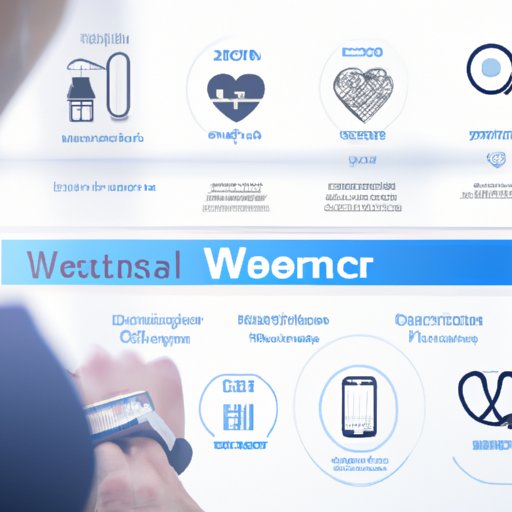Introduction
Wearable technology has become increasingly popular in recent years, with devices such as smart watches and fitness trackers becoming commonplace. But wearable technology is also making its way into healthcare, offering a variety of benefits to patients, clinicians, and healthcare systems alike. In this article, we’ll explore what wearable technology is, the benefits it offers in healthcare, the types of wearables used, and the future of this technology.
Definition of Wearable Technology
According to the American Academy of Family Physicians, wearable technology is “any device that can be worn by a person and that collects data from the environment or from the wearer’s body and transmits that data to another device.” Examples of wearable technology include smart watches, fitness trackers, medical devices, and even clothing with embedded sensors.

Overview of the Benefits of Wearable Technology in Healthcare
Wearable technology can provide a range of benefits in healthcare, including improved patient outcomes, increased cost savings, and enhanced quality of care. These benefits are made possible by the ability of wearables to collect and transmit data, which can be used to monitor and manage health conditions, improve access to care, and provide more personalized treatment plans.

Exploring the Benefits of Wearable Technology in Healthcare
Improved Patient Outcomes
One of the most significant benefits of wearable technology in healthcare is improved patient outcomes. According to a study published in the International Journal of Medical Informatics, wearables can help to improve the management of chronic diseases, such as diabetes and hypertension, by providing real-time data that can be used to adjust treatment plans and monitor progress. This can lead to better outcomes for patients, as well as reduced hospital visits and readmissions.
Increased Cost Savings
In addition to improving patient outcomes, wearable technology can also help to reduce costs for healthcare systems. A study published in Medical Care found that the use of wearables in healthcare could lead to an estimated cost savings of $3.7 billion over five years. This is due to the fact that wearables can help to reduce hospital visits and readmissions, which can be costly for healthcare systems.
Enhanced Quality of Care
Wearable technology can also help to enhance the quality of care provided to patients. By collecting data from the environment or from the wearer’s body, wearables can provide clinicians with more insight into a patient’s condition, allowing them to make more informed decisions about treatment. Wearables can also enable remote monitoring, which can help to ensure that patients receive the care they need even when they are not able to visit a clinician in person.
An In-Depth Look at the Types of Wearable Technology Used in Healthcare
Smart Watches
Smart watches are one of the most popular types of wearables used in healthcare. These devices can be used to monitor a range of vital signs, such as heart rate, blood pressure, and temperature. They can also be used to track activity levels and sleep patterns, as well as remind users to take medications or attend appointments.
Fitness Trackers
Fitness trackers are another type of wearable technology commonly used in healthcare. These devices are designed to monitor physical activity, such as steps taken, calories burned, and distance traveled. They can also be used to track heart rate and sleep quality. Fitness trackers can be a valuable tool for those looking to improve their physical health.
Medical Devices
Medical devices are a type of wearable technology specifically designed for healthcare applications. These devices can be used to monitor a variety of conditions, such as diabetes and hypertension, and provide real-time data that can be used to adjust treatment plans and monitor progress. Medical devices can also be used to deliver drugs or provide pain relief.
Understanding the Impact of Wearable Technology on Patient Outcomes
Improved Disease Management
One of the most significant impacts of wearable technology on patient outcomes is improved disease management. By providing real-time data, wearables can help clinicians to more effectively monitor and manage chronic diseases, leading to better outcomes for patients. In addition, wearables can help to reduce hospital visits and readmissions, which can also lead to improved outcomes.
Improved Access to Care
Wearable technology can also help to improve access to care for patients. By enabling remote monitoring, wearables can help to ensure that patients receive the care they need even when they are not able to visit a clinician in person. This can be especially beneficial for those living in rural areas or those who have difficulty accessing traditional healthcare services.
Improved Health Outcomes
Finally, wearable technology can lead to improved health outcomes for patients. By providing real-time data, wearables can help clinicians to more effectively manage chronic diseases, leading to better outcomes for patients. In addition, wearables can help to improve access to care, which can also lead to improved health outcomes.

Examining the Future of Wearable Technology in Healthcare
The Role of Big Data
As the use of wearable technology in healthcare continues to grow, so too does the amount of data that is being collected. This data can be used to gain insights into health trends, identify risk factors, and develop new treatments and therapies. According to a study published in the International Journal of Medical Informatics, the use of big data in healthcare could lead to better outcomes for patients and improved cost savings for healthcare systems.
The Potential of Artificial Intelligence
The use of artificial intelligence (AI) in healthcare is also beginning to gain traction. AI-based algorithms can be used to analyze large volumes of data collected by wearables and identify patterns that may be indicative of disease or other health issues. This could lead to earlier diagnosis and intervention, as well as more personalized treatments and therapies.
The Integration of Wearables into Healthcare Systems
Finally, wearable technology is beginning to be integrated into existing healthcare systems. This will allow for the seamless exchange of data between wearables and healthcare providers, enabling clinicians to more effectively monitor and manage chronic diseases. It will also allow for the development of new and innovative treatments and therapies.
Conclusion
Wearable technology is quickly becoming an integral part of healthcare, offering a variety of benefits to patients, clinicians, and healthcare systems alike. Wearables can help to improve patient outcomes, reduce costs, and enhance the quality of care. They can also be used to monitor and manage chronic diseases, improve access to care, and provide more personalized treatments. As this technology continues to evolve, it has the potential to revolutionize healthcare in a variety of ways.
(Note: Is this article not meeting your expectations? Do you have knowledge or insights to share? Unlock new opportunities and expand your reach by joining our authors team. Click Registration to join us and share your expertise with our readers.)
